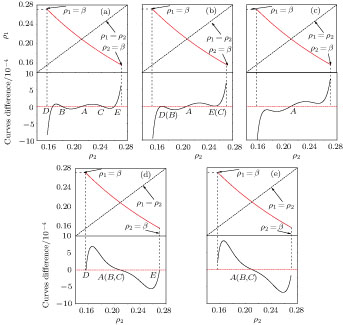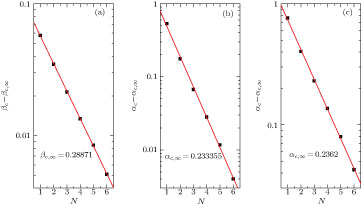† Corresponding author. E-mail:
Project supported by the National Basic Research Program of China (Grant No. 2012CB725404) and the National Natural Science Foundation of China (Grant Nos. 11422221 and 11672289).
As one of the paradigmatic models of non-equilibrium systems, the asymmetric simple exclusion process (ASEP) has been widely used to study many physical, chemical, and biological systems. The ASEP shows a range of nontrivial macroscopic phenomena, among which, the spontaneous symmetry breaking has gained a great deal of attention. Nevertheless, as a basic problem, it has been controversial whether there exist one or two symmetry-broken phases in the ASEP. Based on the mean field analysis and current minimization principle, this paper demonstrates that one of the broken-symmetry phases does not exist in a bidirectional two-lane ASEP with narrow entrances. Moreover, an exponential decay feature is observed, which has been used to predict the phase boundary in the thermodynamic limit. Our findings might be generalized to other ASEP models and thus deepen the understanding of the spontaneous symmetry breaking in non-equilibrium systems.
Statistical investigation of non-equilibrium systems is a tough task. To understand the basic statistical properties of non-equilibrium systems, many paradigmatic models have been proposed. As one of the paradigmatic models of non-equilibrium systems, the asymmetric simple exclusion process (ASEP) has been widely used to study many physical, chemical, and biological systems,[1–5] such as biopolymerization,[6] gel electrophoresis,[7] the kinetics of synthesis of proteins,[8–10] biological transport,[11–16] polymer dynamics in dense media,[17] diffusion through membrane channels,[18] surface growth,[19,20] glassy dynamics,[21,22] traffic flow,[23–26] information flow,[27–29] and so on.
The basic ASEP model is defined on a one-dimensional discrete lattice with L sites that are either occupied by a single particle or empty. Particles move along the lattice obeying a hard-core exclusion principle. This simple model can reproduce many non-equilibrium phenomena such as spontaneous symmetry breaking,[30–42] boundary-induced[43–45] and bulk-induced [46] phase transitions, phase separation and condensation,[47–51] shock formation,[11,12,46,52] and so on. Thus, as Blythe and Evans[4] pointed out, “our interest in the ASEP lies in its having acquired the status of a fundamental model of nonequilibrium statistical physics in its own right in much the same way that the Ising model has become a paradigm for equilibrium critical phenomena.”
The spontaneous symmetry breaking has been studied across various fields. The first ASEP model exhibiting spontaneous symmetry breaking is known as the “bridge model”.[30,31] From then on, the phenomenon in ASEP models has gained a great deal of attention.[32–42] However, the mechanism of this phenomenon is still not well understood. In particular, there are controversial reports about the number of symmetry-broken phases in the bridge model. The existence of one of the symmetry-broken phases (i.e., asymmetric lowdensity/low-density (LD/LD) phase) has been disputed on the basis of computer simulation by Arndt et al.[42] Extensive high-precision Monte Carlo simulations indicated that the phase may disappear in the thermodynamic limit.[32]
In the bridge model, particles moving in opposite directions interact with each other at every site of the lattice. Thus, Pronina and Kolomeisky[33] argued that it is not clear how the interactions between these particles localized in the specific parts of the system will affect the symmetry breaking. Motivated by this fact, they have proposed to study the bidirectional two-lane asymmetric exclusion processes with narrow entrances, in which interactions of particles in the two channels only happen at the entrances.[33] The system has been analyzed using a mean-field theoretical approach and extensive Monte Carlo computer simulations at different system sizes. It has been shown via mean field analysis that the model can also reproduce two phases with broken symmetry, i.e., the asymmetric high-density/low-density (HD/LD) phase, and the asymmetric LD/LD phase.
To study the size-scaling dependence of the asymmetric LD/LD phase in their model, Pronina and Kolomeisky[33] carried out computer simulations for the systems with different sizes up to L = 1.2 × 104. It was shown that “the region of existence for the asymmetric LD/LD phase seems to shrink constantly with increasing L without reaching a saturation, which suggests that the phase probably does not exist in the thermodynamic limit”. However, Pronina and Kolomeisky[33] also claimed that the numerical results are not very conclusive, thus more careful investigations of this phase are needed in order to understand the symmetry breaking phenomenon.
In this paper, we study the issue of whether the asymmetric LD/LD phase exists or not in the bidirectional two-lane ASEP with narrow entrances. We demonstrate that the asymmetric LD/LD phase should not exist based on the mean field analysis and the current minimization principle.
The paper is organized as follows. The model is briefly reviewed in Section
The sketch of the model is shown in Fig.
We first present the results of simple mean field, which ignores correlations between any two sites. Then we present the cluster mean field results, in which the N-cluster mean field analysis and the current minimization principle demonstrate that the asymmetric LD/LD phase does not exist.
Pronina and Kolomeisky[33] presented a simple mean field analysis of the bidirectional two-lane system. They have shown that the necessary conditions for the existence of the asymmetric LD/LD phase are
 | (1) |
When the necessary condition of the existence of the asymmetric LD/LD phase is satisfied, the system current, which is the sum of the currents on the two lanes and denoted as JA, can be calculated
 | (2) |
 | (3) |
 | (4) |
Figure 
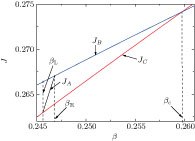 | Fig. 2. (color online) The plot of JA, JB, and JC versus β, obtained from simple mean field analysis. The parameter α = 0.4. |
On the other hand, the curve of JB intersects the curve of JC at βc. This means that when β < βc, the system is in HD/LD phase. When β > βc, the system is in symmetric LD phase.
While simple mean field analysis ignores correlations between any two sites, the correlations in the cluster have been considered in cluster mean field analysis. We number the sites from the entrance site to the exit site as site 1, 2, 3, …, L, see Fig.
 | Fig. 3. Four possible states of the vertical cluster composed of the exit site of lane 1 and entrance site of lane 2 in one cluster mean field analysis |
Due to conservation of probabilities, one has
 | (5) |
Now we can write the master equations of the evolution of the four probabilities.
 | (6) |
 | (7) |
 | (8) |
Next we can analyze the asymmetric LD/LD phase. We express the bulk density of lane 2 as
 | (9) |
 | (10) |
Thus, in the asymmetric LD/LD phase, we have seven variables P00, P01, P10, P11, p1, p2, ρ2 and six equations (
Note that in Ref. [38], we introduce the bulk density of lane 1 as ρ1. Thus, the flow rate on lane 1 is J1 = ρ1(1 − ρ1), so that ρL = ρ1(1 − ρ1)/β. Based on p1(1 − ρL) = J1, we calculate p1 = βρ1(1 − ρ1)/[β − ρ1(1 − ρ1)]. However, a similar analytical relationship between p1 and ρ1 cannot be obtained in an N-cluster case (N > 1) due to the correlations in the cluster.
Next we consider the asymmetric HD/LD phase. Suppose lane 1 is in HD, one has p1 = 1 − β. At the same time, Eqs. (
N-cluster mean field analysis with N > 1 can be carried out similarly and details will not be presented here. With the increase of N, the only assumption (Eq. (
Now we show the results of one-cluster mean field analysis. The black and red lines in Fig.
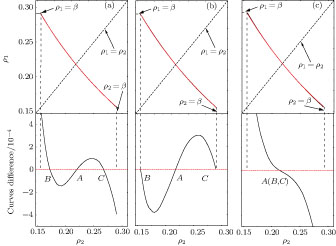 | Fig. 4. (color online) The two curves of ρ1 versus ρ2 (top) and difference of the two curves (bottom). The parameter α = 0.8, (a) β = 0.3095, (b) β = 0.308436257, (c) β = 0.3106. |
Thus, the necessary condition for the existence of an asymmetric LD/LD phase is that there should exist two points B and C such that ρ1 < β at point B and ρ2 < β at point C. Note that in Ref. [35], the necessary condition has been incorrectly presented as ρ1 < 1/2 at point B and ρ2 < 1/2 at point C.
We have compared the three currents JA, JB, and JC. The results are the same as in simple mean field analysis: the asymmetric LD/LD phase does not exist.
Next we perform N-cluster mean field analysis and increase N from 1. The result does not change until N = 4. However, when N > 4, the results become different. Figure
We compare the flow rates of asymmetric HD/LD solution, asymmetric LD/LD solution I, asymmetric LD/LD solution II and symmetric LD solution, see Fig.
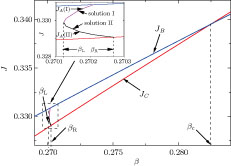 | Fig. 6. (color online) The plot of JA, JB, and JC versus β, obtained from 5-cluster mean field analysis. The parameter α = 0.8. |
We have increased N until N = 6, the result does not change anymore. Although we are not able to prove rigorously, the mean field analysis and the current minimization principle strongly demonstrate that the asymmetric LD/LD phase does not exist.
Figure
Finally we study the dependence of phase boundary on N in N-cluster mean field analysis. Figure
To summarize, this paper studies symmetry breaking phenomenon in a bidirectional two-lane ASEP with narrow entrances, in which it is controversial whether an asymmetric LD/LD phase exists or not. We demonstrate that the asymmetric LD/LD phase should not exist based on mean field analysis and current minimization principle. The cluster mean field analysis performs better than simple mean field analysis. With the increase of N-cluster, the analytical boundaries approach the simulation ones. We observe an exponential decay feature in N-cluster mean field analysis, which has been used to predict the phase boundary in the thermodynamic limit.
The findings can be important for the understanding of the symmetry breaking phenomenon in non-equilibrium systems. The method adopted here might be generalized to other ASEP models. The results can also shed some light on the dynamics of pedestrian flow, traffic flow and biological transport.
| [1] | |
| [2] | |
| [3] | |
| [4] | |
| [5] | |
| [6] | |
| [7] | |
| [8] | |
| [9] | |
| [10] | |
| [11] | |
| [12] | |
| [13] | |
| [14] | |
| [15] | |
| [16] | |
| [17] | |
| [18] | |
| [19] | |
| [20] | |
| [21] | |
| [22] | |
| [23] | |
| [24] | |
| [25] | |
| [26] | |
| [27] | |
| [28] | |
| [29] | |
| [30] | |
| [31] | |
| [32] | |
| [33] | |
| [34] | |
| [35] | |
| [36] | |
| [37] | |
| [38] | |
| [39] | |
| [40] | |
| [41] | |
| [42] | |
| [43] | |
| [44] | |
| [45] | |
| [46] | |
| [47] | |
| [48] | |
| [49] | |
| [50] | |
| [51] | |
| [52] | |
| [53] |



